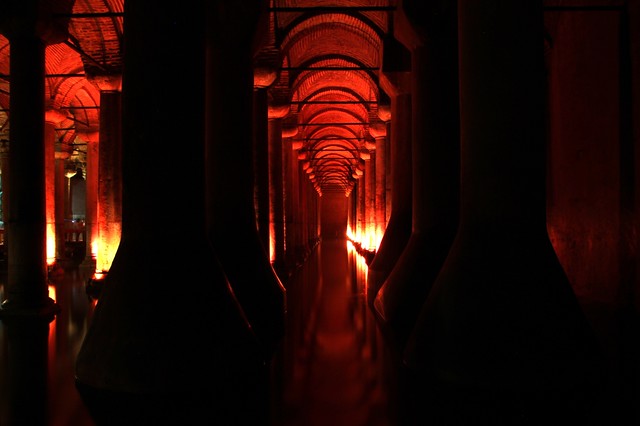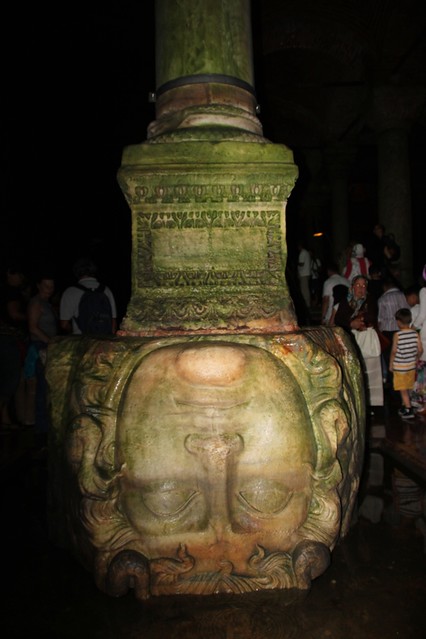

H Βασιλική Κινστέρνα ή Yerebatan Saray (Γερεμπατάν Σαράι - υπόγειο παλάτι), στα Τουρκικά, είναι η μεγαλύτερη από τις αρκετές εκατοντάδες υπογείων δεξαμενών νερού που υπάρχουν στην Κωνσταντινούπολη από τους Βυζαντινούς χρόνους. Έχει διαστάσεις περίπου 141 μέτρα μήκος και 66,5 μέτρα πλάτος στην κάτοψη και η χωρητικότητα της είναι 78.000 κυβικά. Βρίσκεται στον πρώτο λόφο της πόλης, περίπου 150 μέτρα νοτιοδυτικά της Αγίας Σοφίας, στην περιοχή Σουλτάν Αχμέτ επί του ιστορικού κέντρου. Ονομάστηκε έτσι λόγω της θέσης της, κάτω από τη Βασιλική Στοά που βρισκόταν δυτικά του Αυγουσταίου. Η στοά χτίστηκε πιθανώς από τον Μεγάλο Κωνσταντίνο αλλά καταστράφηκε περίπου το 475. Η κινστέρνα διαμορφώθηκε ως έχει σήμερα όταν ξαναχτίστηκε από τον αυτοκράτορα Ιουστινιανό Α', μετά την περίοδο της Στάσης του Νίκα. Υπήρξε πιθανότατα η κύρια πηγή νερού της περιοχής σε ολόκληρη τη βυζαντινή περίοδο. Ο ιστορικός Προκόπιος παραδίδει μια περιγραφή της κινστέρνας, σημειώνοντας πως φρέσκο νερό μεταφερόταν σε αυτή με τη βοήθεια αγωγού, ενώ εκεί αποθηκευόταν επίσης μια ποσότητα νερού, το οποίο συνήθως αφθονούσε σε άλλες εποχές εκτός του καλοκαιριού. Μετά την κατάκτηση της πόλης από τους Οθωμανούς, φαίνεται πως χάθηκε η γνώση για την κινστέρνα, η οποία όμως ανακαλύφθηκε αργότερα από τον Pierre Gilles κατά την περιήγησή του στην Κωνσταντινούπολη στα μέσα του 16ου αιώνα.

Η κινστέρνα είχε αρχικά 336 κίονες, τοποθετημένους σε 12 σειρές με 28 κίονες η καθεμία, ωστόσο 60 από αυτούς, στη νοτιοδυτική πλευρά, εντοιχίστηκαν και δεν είναι πλέον ορατοί. Στους κίονες εδράζονται σταυροθόλια φτιαγμένα από οπτοπλίνθους. Μεγάλο μέρος της δεξαμενής είναι κατασκευασμένο από ερείπια παλαιότερων κτιρίων, πιθανότατα γιατί επρόκειτο για υπόγειο, μη ορατό κτίσμα, αν και ορισμένα στοιχεία του αρχιτεκτονικού διάκοσμου είναι αξιοσημείωτα.

Δύο κίονες που στηρίζονται σε βάσεις της κλασικής περιόδου και βρίσκονται στη βορειοανατολική πλευρά της κινστέρνας, υποβαστάζονται από ογκόλιθους όπου έχουν σκαλιστεί δύο ογκώδη γοργόνεια, ένα από αυτά τοποθετημένο ανάποδα και το άλλο στο πλάι. Οι κίονες ίσως προέρχονται από κάποιο νυμφαίο και οι δύο κεφαλές τοποθετήθηκαν πιθανώς από τον Ιουστινιανό.

Στο κέντρο της κινστέρνας ξεχωρίζει επίσης κίονας που φέρει ανάγλυφο σταγονοειδές μοτίβο, το οποίο εμφανίζει ομοιότητα με άλλους μνημειακούς κίονες που αποτελούσαν μέρος της θριαμβικής αψίδας του 4ου αιώνα από το Φόρο του Θεοδοσίου.
Από τον 18ο και μέχρι τα μέσα του 20ου αιώνα, πραγματοποιήθηκαν έργα αναστήλωσης για τη διατήρηση της κινστέρνας, η οποία μετά από ανακαίνιση που ξεκίνησε το 1985, είναι από το 1987 ανοιχτή στο ευρύ κοινό και συνιστά ένα από τους σπουδαιότερους και παλαιότερους δημόσιους χώρους.
Πηγή: Βικιπαίδεια
Η επίσημη ιστοσελίδα της Βασιλικής Κινστέρνας εδώ.
[ENG] The Basilica Cistern is the largest of several hundred ancient cisterns that lie beneath the city of Constantinople (today Istanbul, Turkey). The cistern, located 150 meters southwest of Hagia Sophia, was built in the 6th century during the reign of Byzantine Emperor Justinian I. The name of this subterranean structure derives from a large public square on the First Hill of Constantinople, the Stoa Basilica, beneath which it was originally constructed. According to ancient historians, Emperor Constantine constructed a structure which was later rebuilt and enlarged by Emperor Justinian after the Nika riots of 532, which devastated the city. Historical texts claim that 7,000 slaves were involved in the construction of the cistern. The enlarged cistern provided a water filtration system for the Great Palace of Constantinople and other buildings on the First Hill, and continued to provide water to the Topkapi Palace after the Ottoman conquest in 1453 and into modern times This cathedral-sized cistern is an underground chamber approximately 138 metres by 64.6 metres - about 9,800 square metres in area - capable of holding 78,000 cubic metres of water. The ceiling is supported by a forest of 336 marble columns, each 9 metres high, arranged in 12 rows of 28 columns each spaced 4.9 metres apart. The capitals of the columns are mainly Ionic and Corinthian styles, with the exception of a few Doric style with no engravings. One of the columns is engraved with raised pictures of a Hen's Eye, slanted branches, and tears. This column resembles the columns in the Triumphal Arch of Great Theodesius from the 4th century (379-395), erected in the "Farum Tauri" Square during the Byzantine Empire. Ancient texts suggest that the tears on the column pay tribute to the hundreds of slaves who died during the construction of the Basilica Cistern. The majority of the columns in the cistern appear to have been relocated from older buildings, likely brought to Constantinople from various parts of the empire, together with those that were used in the construction of Hagia Sophia. They are carved and engraved out of various types of marble and granite. 52 stone steps descend into the entrance of the cistern. The cistern is surrounded by a fire-brick wall with a thickness of 4 metres and coated with a waterproofing mortar. The Basilica Cistern's water came from the Eğrikapı Water Distribution Centre in the Belgrade Forest; which lie 19 kilometres north of the city. It travelled through the 971 metres long Valens Aqueduct (Bozdoğan), and the 115.45 metres long Mağlova Aqueduct, which was built by the Emperor Justinianus. The cistern has the capacity to store 78,000 tons of water, despite being virtually empty today with only a few feet of water lining the bottom. The weight of the cistern lies on the columns by mean of the cross-shaped vaults and round arches of its roof. The Basilica Cistern has undergone several restorations since its foundation. The first of the repairs were carried out twice during the Ottoman State in the 18th century during the reign of Ahmed III in 1723 by architect Muhammad Agha of Kayseri. The second major repair was completed during the 19th century during the reign of Sultan Abdulhamid II (1876–1909). Cracks to masonry and damaged columns were repaired in 1968, with additional restoration in 1985 by the Istanbul Metropolitan Museum. During the 1985 restoration, 50,000 tons of mud were removed from the cisterns, and a platforms built throughout to replace the boats once used to tour the cistern. The cistern was opened to the public in its current condition on 9 September 1987. In May 1994 the cistern underwent additional cleaning. Located in the northwest corner of the cistern, the bases of two columns reuse blocks carved with the visage of Medusa. The origin of the two heads is unknown, though it is thought that the heads were brought to the cistern after being removed from a building of the late Roman period. There is no written evidence that suggests they were used as column pedestals previously. Tradition has it that the blocks are oriented sideways and inverted in order to negate the power of the Gorgons' gaze, however it is widely thought that they were placed sideways and upside down only to be the proper size to support their columns. [Source: Wikipedia]








1 comment:
Did you missed it? There was a huge stone with a small hole. People were putting their fingers in it and making circles :) It had worn from the time, quite interesting :)
Post a Comment